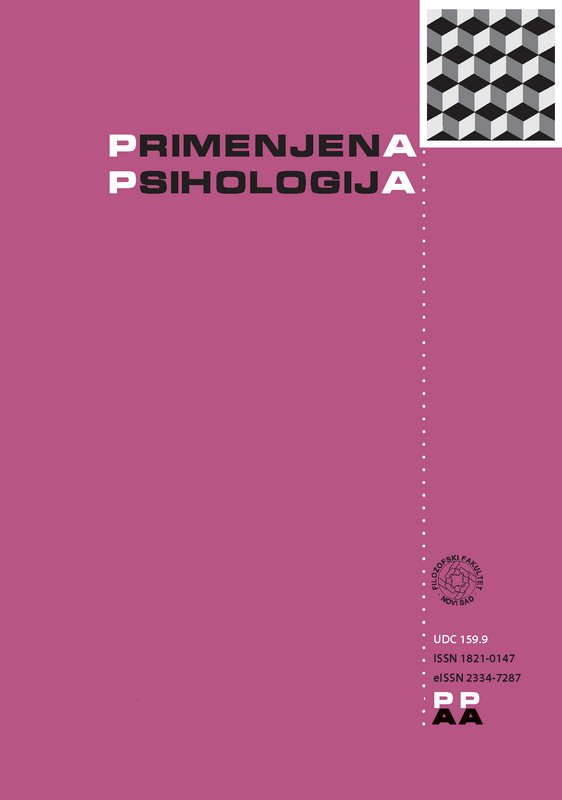FACIAL EXPRESSIONS RECOGNITION IN PHOTOGRAPHS, DRAWINGS, AND EMOTICONS
DOI:
https://doi.org/10.19090/pp.2020.3.293-309Keywords:
drawing of a human face, emoticon, emotions, photo of a human faceAbstract
Results of previous studies point to the importance of different face parts for certain emotion recognition, and also show that emotions are better recognized in photographs than in caricatures of faces. Therefore, the aim of the study was to examine the accuracy of recognizing facial expression of emotions in relation to the type of emotion and the type of visual presentations. Stimuli contained facial expressions, shown as a photograph, face drawing, or as an emoticon. The task for the participant was to click on the emotion he thought was shown on the stimulus. As factors, the type of displayed emotion varied (happiness, sorrow, surprise, anger, disgust, fear), as well as the type of visual presentation (photo of a human face, a drawing of a human face and an emoticon). As the dependent variable, we used the number of accurately recognized facial expressions in all 18 situations. The results showed that there is an interaction of the type of emotion being evaluated and the type of visual presentation, F(10; 290) = 10.55, p < .01, ŋ2 = .27. The facial expression of fear was most accurately assessed in the drawing of the human face. Emotion of sorrow was most accurately recognized in the assessment of emoticon, and the expression of disgust was recognized worst on the emoticon. Other expressions of emotions were equally well assessed independently of the type of visual presentation. The type of visual presentation has proven to be important for recognizing some emoticons, but not for all of them.
Metrics
References
Adolphs, R., Gosselin, F., Buchanan, T. W., & Tranel, D. (2005). A mechanism for impaired fear recognition after amygdala damage. Nature, 433(7021), 68–72. https://doi.org/10.1038/nature03086
Biehl, M., Matsumoto, D., Ekman, P., Hearn, V., Heider, K., Kudoh, T., & Ton, V. (1997). Matsumoto and Ekman's Japanese and Caucasian Facial Expressions of Emotion (JACFEE): Reliability data and cross-national differences. Journal of Nonverbal Behavior, 21(1), 3–21. https://doi.org/10.1023/a:1024902500935
Ekman, P. (1992). An argument for basic emotions. Cognition & Emotion, 6(3–4), 169–200. https://doi.org/10.1080/02699939208411068
Ekman, P., & Friesen, W. V. (1975). Unmasking the face Englewood Cliffs. Spectrum-Prentice Hall.
Fox, E., Lester, V., Russo, R., Bowles, R. J., Pichler, A., & Dutton, K. (2000). Facial expressions of emotion: Are angry faces detected more efficiently? Cognition & Emotion, 14(1), 61–92. https://doi.org/10.1080/026999300378996
Groh, B. N. (2017). Impact of Expressive Intensity and Stimulus Location on Emotion Detection (Unpublished master Thesis). The Faculty of the Department of Psychological Sciences Western Kentucky University Bowling Green, KY.
Kostić, A. (2014). Govor lica – značenje facijalnog ponašanja [Facial expression - the meaning of facial behavior]. Faculty of Philosophy in Niš.
Lewkowicz, D. J., & Hansen-Tift A. M. (2012). Infants deploy selective attention to the mouth of a talking face when learning speech. Proceedings of the National Academy of Sciences, 109(5), 1431–1436. https://doi.org/10.1073/pnas.1114783109
Matsumoto, D., & Ekman, P. (1988). Japanese and Caucasian Facial Expressions of Emotion (JACFEE) and Neutral Faces (JACNeuF). Department of Psychiatry, University of California.
Matsumoto, D., LeRoux, J., Wilson-Cohn, C., Raroque, J., Kooken, K., Ekman, P., & Amo, L. (2000). A new test to measure emotion recognition ability: Matsumoto and Ekman's Japanese and Caucasian Brief Affect Recognition Test (JACBART). Journal of Nonverbal Behavior, 24(3), 179–209. https://doi.org/10.1023/A:1006668120583
Mermillod, M., Vuilleumier, P., Peyrin, C., Alleysson, D., & Marendaz, C. (2009). The importance of low spatial frequency information for recognising fearful facial expressions. Connection Science, 21(1), 75–83. https://doi.org/10.1080/09540090802213974
Palermo, R., & Coltheart, M. (2004). Photographs of facial expression: Accuracy, response times, and ratings of intensity. Behavior Research Methods, Instruments, and Computers, 36(4), 634–638. https://doi.org/10.3758/bf03206544
Passarell, M., Masini, M., Bracco, F., Petrosino, M., & Chiorri, C. (2018). Development and validation of the Facial Expression Recognition Test (FERT). Psychological Assessment, 30(11), 1479–1490. https://doi.org/10.1037/pas0000595
Pochedly, J.T., Widen, S.C., & Russell, J.A. (2012). What emotion does the “facial expression of disgust” express? Emotion, 12(6), 1315–1319. https://doi.org/10.1037/a0027998
Todić, T. (2013). Pojedinac u savremenom društvu i prepoznavanje facijalne ekspresije emocija [An individual in modern society and recognition of emotional facial expressions]. In M. Krstić & B. Jovanović (Ur.) Međunarodni tematski zbornik: Pojedinac, porodica, društvo u tranziciju (pp. 117–130). Faculty of Philosophy in Kosovska Mitrovica, University of Priština.
Wegrzyn, M., Vogt, M., Kireclioglu, B., Schneider, J., & Kissler, J. (2017). Mapping the emotional face. How individual face parts contribute to successful emotion recognition. PLoS ONE, 12(5), 1–15. https://doi.org/10.1371/journal.pone.0177239
Yang, Y. H., & Yeh, S.L. (2018). Unconscious processing of facial expression as revealed by affective priming under continuous flash suppression. Psychonomic Bulletin & Review, 25(6), 2215–2223. https://doi.org/10.3758/s13423-018-1437-6
Zhao, J., Meng, Q., An, L., & Wang, Y. (2019). An event-related potential comparison of facial expression processing between cartoon and real faces. PLoS ONE, 14(1), 1–13. https://doi.org/10.1371/journal.pone.0198868







